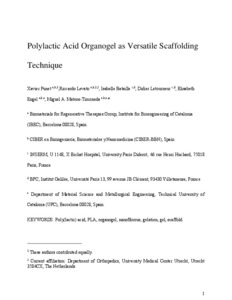Mostra el registre d'ítem simple
Polylactic acid organogel as versatile scaffolding technique
| dc.contributor.author | Punet, Xavier |
| dc.contributor.author | Levato, Riccardo |
| dc.contributor.author | Bataille, Isabelle |
| dc.contributor.author | Letourneur, Didier |
| dc.contributor.author | Engel López, Elisabeth |
| dc.contributor.author | Mateos Timoneda, Miguel Ángel |
| dc.contributor.other | Universitat Politècnica de Catalunya. Departament de Ciència dels Materials i Enginyeria Metal·lúrgica |
| dc.date.accessioned | 2017-03-14T10:07:20Z |
| dc.date.available | 2019-03-26T01:31:09Z |
| dc.date.issued | 2017-03-24 |
| dc.identifier.citation | Punet, X., Levato, R., Bataille, I., Letourneur, D., Engel, E., Mateos, M. Polylactic acid organogel as versatile scaffolding technique. "Polymer", 24 Març 2017, vol. 113, p. 81-91. |
| dc.identifier.issn | 0032-3861 |
| dc.identifier.uri | http://hdl.handle.net/2117/102421 |
| dc.description.abstract | Tissue engineering requires scaffolding techniques based on non-toxic processes that permits the fabrication of constructs with tailored properties. Here, a two-step methodology based on the gelation and precipitation of the poly(lactic) acid/ethyl lactate organogel system is presented. With this technique nanofibrous matrices that resemble natural extracellular matrix can be easily obtained, while allowing control over the mechanical properties of the device. Gelation temperature and the dynamics of the gelation of the organogel system are characterized, and the final mechanical and viscoelastic properties, as well as porosity, as function of the initial polymer concentration are described. We show that gelation temperature of the system is concentration independent and below 44.5 °C, which permits gelation at room temperature. Furthermore, mechanical properties are found in the range of the soft organic tissues, and the obtained micro-network architecture gives place to a flexible structure. Such structure presents tuneable elastic modulus and viscoelastic properties as function of nanofibers density. Moreover, centimetre-long tubular scaffolds with the diameter of medium-caliber blood vessels were produced. The fibrous nano-architecture mimics the native extracellular matrix fibres diameter and morphology was proven to be suitable to support endothelialization of the lumen of the tube. Thus, this strategy, based on biocompatible green compound might be promising for the fabrication of large 3D scaffolds for tissue engineering application |
| dc.format.extent | 11 p. |
| dc.language.iso | eng |
| dc.publisher | Elsevier |
| dc.rights.uri | http://creativecommons.org/licenses/by-nc-nd/3.0/es/ |
| dc.subject | Àrees temàtiques de la UPC::Enginyeria dels materials |
| dc.subject.lcsh | Tissue engineering |
| dc.subject.lcsh | Polylactic acid |
| dc.subject.lcsh | Biomedical materials |
| dc.subject.other | Poly(lactic) acid |
| dc.subject.other | PLA |
| dc.subject.other | Organogel |
| dc.subject.other | Nanofibrous |
| dc.subject.other | Gelation |
| dc.subject.other | Gel |
| dc.subject.other | Scaffold |
| dc.title | Polylactic acid organogel as versatile scaffolding technique |
| dc.type | Article |
| dc.subject.lemac | Enginyeria de teixits |
| dc.subject.lemac | Àcid polilàctic |
| dc.subject.lemac | Materials biomèdics |
| dc.contributor.group | Universitat Politècnica de Catalunya. BBT - Biomaterials, Biomecànica i Enginyeria de Teixits |
| dc.identifier.doi | 10.1016/j.polymer.2017.02.056 |
| dc.description.peerreviewed | Peer Reviewed |
| dc.relation.publisherversion | http://www.sciencedirect.com/science/article/pii/S0032386117301805 |
| dc.rights.access | Open Access |
| local.identifier.drac | 19786506 |
| dc.description.version | Postprint (author's final draft) |
| local.citation.author | Punet, X.; Levato, R.; Bataille, I.; Letourneur, D.; Engel, E.; Mateos, M. |
| local.citation.publicationName | Polymer |
| local.citation.volume | 113 |
| local.citation.startingPage | 81 |
| local.citation.endingPage | 91 |
Fitxers d'aquest items
Aquest ítem apareix a les col·leccions següents
-
Articles de revista [960]
-
Articles de revista [439]


